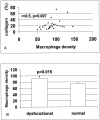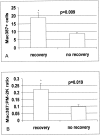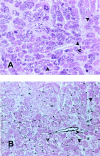Evidence for an active inflammatory process in the hibernating human myocardium
- PMID: 11943726
- PMCID: PMC1867231
- DOI: 10.1016/S0002-9440(10)62568-0
Evidence for an active inflammatory process in the hibernating human myocardium
Abstract
Myocardial hibernation refers to a state of prolonged impairment of left ventricular function in the presence of coronary artery disease, which may be reversed by revascularization. In this study we present evidence for a local inflammatory reaction in hibernating myocardial segments from patients undergoing coronary revascularization. We obtained transmural myocardial biopsies guided by transesophageal echocardiography from patients with ischemic ventricular dysfunction undergoing bypass surgery. Among the 28 biopsied segments included in the study, 23 showed evidence of systolic dysfunction. The majority of dysfunctional segments (85.7%) were viable ((201)Tl uptake >/= 60%). The samples were stained with markers for mast cells, mature resident macrophages, and the monoclonal antibody Mac387 that labels newly recruited myeloid cells. Dysfunctional segments showed more extensive fibrosis and higher macrophage density than normal segments. Among the 23 dysfunctional segments, 12 recovered function as assessed with echocardiograms 3 months after revascularization. Segments with postoperative functional recovery had comparable macrophage and mast cell density with those showing persistent dysfunction. However, biopsied segments that subsequently recovered function contained significantly higher numbers of newly recruited Mac387-positive leukocytes (18.7 +/- 3.1 cells/mm(2), n = 12 versus 8.6 +/- 0.9 cells/mm(2), n = 11; P = 0.009). In addition, monocyte chemotactic protein-1, a potent mononuclear cell chemoattractant, was predominantly expressed in segments with recovery of function. Myocardial hibernation is associated with an inflammatory response leading to active leukocyte recruitment. Dysfunctional myocardial segments that show an active inflammatory reaction have a greater potential for recovery of function after revascularization. We postulate that revascularization may promote resolution of the ongoing inflammation, preventing further tissue injury and fibrosis.
Figures









References
-
- Rahimtoola SH: Concept and evaluation of hibernating myocardium. Annu Rev Med 1999, 50:75-86 - PubMed
-
- Rahimtoola SH: A perspective on the three large multicenter randomized clinical trials of coronary bypass surgery for chronic stable angina. Circulation 1985, 72:V123-V135 - PubMed
-
- Heusch G: Hibernating myocardium. Physiol Rev 1998, 78:1055-1085 - PubMed
-
- Elsasser A, Schaper J: Hibernating myocardium: adaptation or degeneration? Basic Res Cardiol 1995, 90:47-48 - PubMed
Publication types
MeSH terms
Substances
Grants and funding
LinkOut - more resources
Full Text Sources
Research Materials

